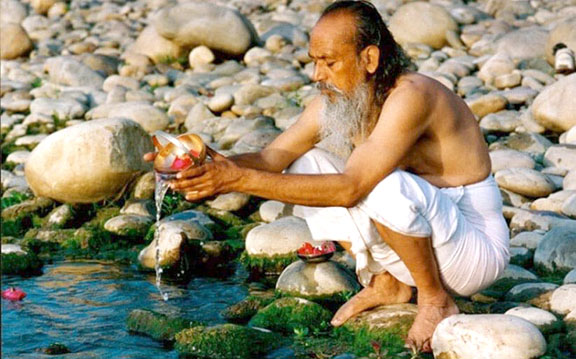
(Photo: Baba Hari Dass, who inspired the founding of Mount Madonna Center.)
Both Ayurveda and Yoga accept the principles of Samkhya philosophy. While there are many foundational principles, for our purposes, let’s look at a few. Sadkaryavad is the first, the principle of cause and effect. For everything that exists in the universe, there is a cause. If we can find the cause of a malady, and can remove the cause, we create the opening for the person to come back into balance and heal. Next, let’s consider loka purusha siddhanta; we are microcosms of the macrocosm.
Everything that we find within ourselves can be found in the universe; everything in the universe can be found within us. Underlying that understanding is the panchamahabhuta theory, the principle of that everything that exists in the universe is made up of Five Great Elements: Space, Air, Fire, Water and Earth.
These elements have inherent qualities, and once we know the qualities of each, we can use the principle of samanya vishesha siddhanta, “like increases like; opposites decrease” to bring about balance, healthy, harmony and healing in our mind-body complex.
5 Elements and Ayurvedic Healing
As these are so important to Ayurvedic healing, let’s look at the five elements that make up our physical universe:
Space
The quality of emptiness. That in which all creation takes place, that which holds up creation. We see space around us in our homes, our continent, our universe. We recognize space within us, space in each cell, space in all of the orifices of the body. (Qualities: subtle, light, clear, soft)
Air
The quality of movement. We know a light breeze can move the leaves on the trees or a powerful hurricane can lift them up by the roots. We see the effect of air in our digestive tract, moving the food along, in the circulation of our blood, in the movement of our eyes. (Qualities: dry, rough, cold, mobile, light, subtle)
Fire
The quality of radiance/heat. In our world, we see the sunlight, feel the heat of a lightbulb and enjoy foods cooked over a flame. In our bodies, we note the metabolic fire of digestion, the fire in the eyes, the warmth of the skin. (Qualities: hot, clear, sharp, light, dry, subtle, spreading)
Water
The quality of liquidity. Around us we see liquidity in the oceans, rivers, streams and rain. Our bodies are filled with liquid: interstitial fluids, blood, lymph, tears, saliva, urine. (Qualities: liquid, heavy, cold, dull, soft, oily, slimy)
Earth
The principle of solidity. We find this around us in the rocks, the trees, the minerals, metals, any and all building blocks. Inside us it’s our bones, muscles, tendons, ligaments, cartilage… our physical structure. (Qualities: gross, dense, static, heavy, cool, dull, hard)
Practical Ayurveda: Therapeutic Tools for Working with Energy
How do we apply this Ayurvedic knowledge in practical terms? Remember the principle “like increases like and opposites decrease”?
Let’s say you are feeling ungrounded, flighty, anxious, unable to make a decision. Those qualities come from excess air element. You need to balance air with earth and water. For example, for your asana practice, instead of a standing, flowing series of poses, you may need a slow, strong hatha practice with plenty of seated poses.
For pranayama, instead of skull shining (kapalabhati) which consists of short, forced exhales, you might try a slow, long exhale (dirgarechaka) or even reclined abdominal breathing.
For a meditation practice, you might choose a mantra to tether the mind by constant repetition. This could replace an awareness meditation where the mind has a tendency to run away like wild horses.
If you were to add all three practices you would be much more likely to rebalance the air element in the mind-body complex and thereby reduce anxiety and increase stability.
 About the Author:
About the Author:

